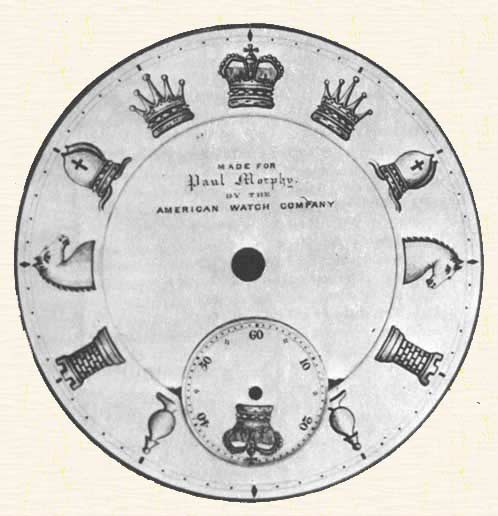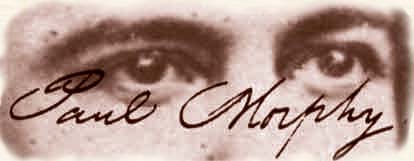|
Presented to Paul Morphy on May 25, 1859

(from the testimonial program)
The movements of this watch were made entirely by machinery, and
it's interior and exterior presents as elegant a specimen of art as well can be
imagined. The whole is highly creditable to the celebrated makers and to
American ingenuity.

The stem and pendant is exquisitely carved, so as to represent a
King's crown. It is set round with brilliants, and another large diamond at its
top, which answers for a push-piece by which to open the watch. Upon one lid the
United States coat of arms is richly carved in relief. on the other lid, also in
relief, the monogram:
P. M.
Instead of the usual Roman numerals on the dial, the hours are
represented by various pieces of chess, finely done in red and black - the Black
King standing at twelve, and the Red King at six, the Queens at one and eleven,
Bishops at two and ten, Knights at three and nine, Castles at four and eight,
and Pawns at five and seven. The cap is engraved with the following inscription:
TO PAUL MORPHY
From the testimonial committee of New York
Chess Club as their tribute to his genius
and worth
New York, May, 1859
Morphy visited the American Watch Company in Waltham on May 30, 1859,
during his visit to Boston and was given a tour of the
facility by the proprietor. Undoubtedly, Morphy was asked keep them informed
concerning the accuracy of his one-of-a-kind timepiece since on October 5,
1859, he wrote the following letter (which was subsequently published on
October 15 in the New York Saturday Press.)
New York, October 5, 1859
Mr. R. E. Robbins, Treas.
Am. Watch Company:
Dear Sir:
The American watch, No. 9240,
presented me by the New York Chess-Club has proved to be a most reliable
and accurate time-keeper - almost unnecessarily so for ordinary
purposes. It is now nearly five months since it came into my possession,
and during that period its variation from standard time has been but a
trifle more than half a minute. The following is a record of its
performance. It was set July 3rd correctly:
June 15, fast 4 seconds
Aug. 15, fast 18 seconds
July
1, " 6
"
Sept. 1, " 23
"
" 15,
" 10 "
" 15, "
28 "
Aug. 1,
" 16 "
Oct. 1, "
32 "
I give permission to make use of this statement as you
may think proper. I am, with respect, yours truly,
Paul Morphy
return |

